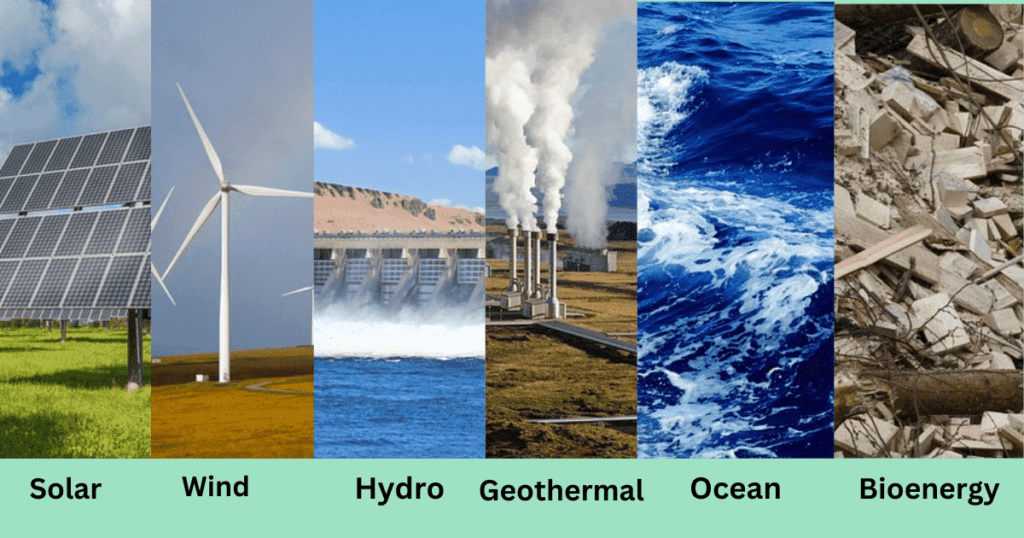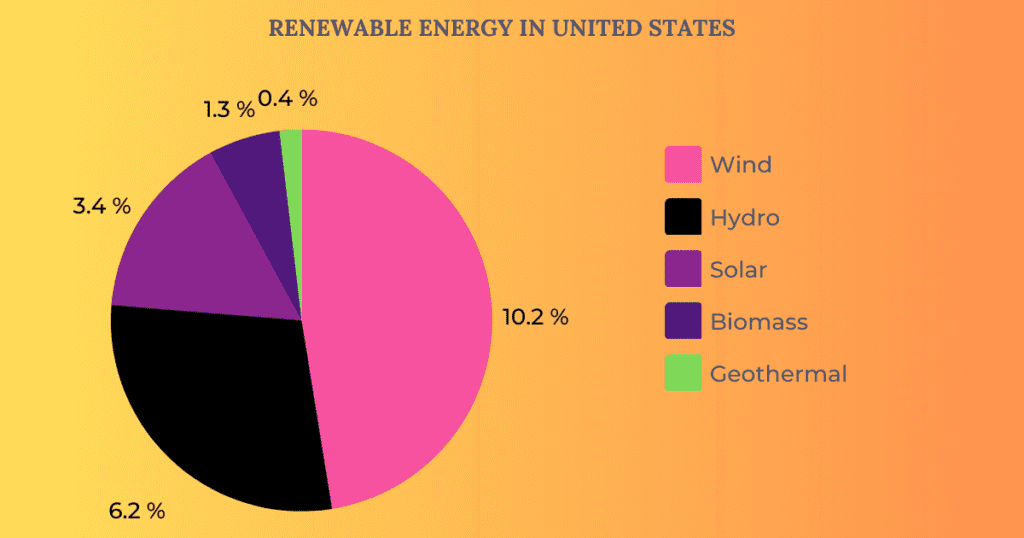Last updated on March 31st, 2024 at 01:09 pm
Renewable energy is not only the future, it’s the present. If you look around yourself, you will observe that the renewable energy sources such as solar, wind, and hydroelectric power are changing the way we live, work, and see through the world. Have you ever thought that renewable energy can reduce our dependence on foreign oil and create local job opportunities?
But how exactly does renewable energy work, what makes it a better choice than traditional fossil fuels and what is the advantage of renewable energy over non-renewable sources? In this article, we’ll explore the benefits and impacts of renewable energy in our life, environment, society, and planet.
What is renewable energy?
Renewable energy is derived from natural resources that can be replenished and they never run out. Unlike non-renewable energy sources, renewable energy sources are everlasting, such as sun, wind, rain, geothermal heat, etc. These types of energy can be used without depleting the Earth’s natural resources.
Why is renewable energy important?
Renewable energy is important for several reasons, for example, it is cleaner and more sustainable. Renewable energy sources don’t create air pollution, greenhouse emission, or global warming. As a result, the use of renewable energy helps us to reduce pollution and combat climate change. Renewable energy can also reduce our dependence on foreign oil and gas, and create jobs in the growing renewable energy industry.
What are some examples of renewable energy sources?
Here are some examples of commonly used renewable energy sources:
- Solar Energy: Solar energy is derived from the sun and is harnessed using solar panels. Solar panels convert sunlight into electricity that can be used to power homes, farming, businesses, and other applications.
- Wind Energy: Wind energy is generated by harnessing the power of wind turbines. Wind turbines convert the kinetic energy of wind into electricity that can be used to power homes and businesses.
- Hydropower: Hydropower is generated by harnessing the energy of moving water. Hydroelectric dams use the force of falling water to turn turbines and generate electricity.
- Geothermal Energy: Geothermal energy is derived from the heat of the earth. Geothermal power plants harness the heat from underground reservoirs of hot water and steam to generate electricity.
- Ocean Energy: Ocean energy is generated by harnessing the power of waves, tides, and currents. Ocean energy technologies include tidal turbines, wave energy converters, and ocean thermal energy conversion.
- Bioenergy: Bioenergy is derived from organic matter such as plants, agricultural waste, and forestry residues. Bioenergy technologies include biomass power plants, biogas production, and biofuels.

What are the five advantages and disadvantages of renewable energy?
Here are the pros and cons of renewable energy.
Advantages:
- It is a clean, cheap and sustainable source of energy
- It reduces our dependence on fossil fuels and foreign oil
- It creates jobs in the renewable energy industry
- It can help combat climate change by reducing greenhouse gas emissions
- It can provide energy security for communities and regions that are not connected to a centralized power grid
Disadvantages:
- It can be intermittent and less reliable than traditional energy sources
- It requires a significant initial investment in infrastructure and technology
- It can have an impact on wildlife and natural habitats in certain circumstances
- It can require a large amount of land for some sources, such as wind and solar power
- It can have a visual impact on the landscape and communities where it is implemented.
What is the best type of renewable energy source?
All renewable energy sources are best. The best type of renewable energy source depends on several factors, including location, climate, and available resources. In some areas, solar power may be the most effective source of renewable energy, while in others, wind power or hydropower may be more suitable. Ultimately, the best approach is to use a combination of renewable energy sources to ensure a reliable and sustainable energy supply.
Why can’t we just switch to renewable energy?
You are probably thinking that, if renewable energy has so many benefits over non-renewable energy sources, for example, fossil fuel, then why don’t we discard non-renewable sources and shifts directly to renewable energy? It is a complex question with multiple answers.
While the switch to renewable energy sources is important, it’s not as simple as just flicking a switch. A number of factors must be considered, including the high upfront cost of renewable energy infrastructure, the intermittency of some renewable energy sources and the need for energy storage technologies.
On the other hand, we have built technologies, industries and transportation based on the non-renewable energy sources. Switching directly to renewable energy, our modern infrastructure and industries may collapse and we can suffer a huge economic crisis. We must shift to renewable energy gradually over the years of time.
Which countries use renewable energy the most?
Following the research-based data of Climate Council and Our world in data here are the list of the countries which use most renewable energies to generate electricity and other energy needs:
- Uruguay: Generates 98% of its electricity from renewable sources.
- Germany: Has made significant strides in wind and solar power, and renewable energy accounts for 43% of its electricity consumption.
- Denmark: Generates 41% of its electricity from wind power and has set a goal to be entirely carbon neutral by 2050.
- China: Is the world’s largest producer of renewable energy and renewable energy accounts for 11% of its energy consumption.
- India: Has set a target to generate 175 GW of renewable energy by 2022 and 450 GW by 2030, with significant investments in solar and wind power. As of 2021, renewable energy accounts for 25% of India’s installed power capacity and 10% of its electricity generation.
- Brazil: Generates 45% of its electricity from renewable sources, with significant investments in hydropower and biofuels.
- Costa Rica: Generates 98% of its electricity from renewable sources and has set a goal to be entirely carbon neutral by 2050.
- Sweden: Generates 54% of its electricity from renewable sources and has a goal to be entirely fossil fuel-free by 2045.
- Scotland: Generates 97% of its electricity from renewable sources, particularly wind power.
- Portugal: Generates 57% of its electricity from renewable sources and is on track to generate 80% by 2030.
- Nicaragua: Generates 70% of its electricity from renewable sources, with significant investments in geothermal power.
What role does renewable energy play in the United States?
USA is doing great! Renewable energy plays an increasingly important role in the United States. In recent years, there has been significant growth in the use of renewable energy sources, particularly in the areas of wind and hydropower. According to the US Energy Information Administration data of 2022, out of the total electricity generated, 60% was produced from non-renewable fossil fuels such as coal, natural gas, petroleum, and other gases. Nuclear energy contributed to approximately 18%, while renewable energy sources contributed to around 22%.
In 22% of the total renewable energy, wind energy contributes 10.2%, hydropower contributes 6.2% , solar energy contributes 3.4%, bioenergy contributes 1.3% and geothermal energy contributes 0.4%. Many states have established renewable energy targets, and the federal government has provided incentives (such as solar tax credits) to encourage the adoption of renewable energy.

What are the limitations of renewable energy sources?
Renewable energy sources have some limitations, including their intermittency and variability, which can make it difficult to provide a consistent and reliable supply of energy. Renewable energy sources totally depend on the climate of the location.
Production of renewable energy is dependent on sunlight, wind and waterflow. Additionally, the initial investment in renewable energy infrastructure can be expensive. In addition, sources, such as wind and solar power, require a large amount of land to generate significant amounts of electricity. There can also be challenges in integrating renewable energy into existing power grids.
What renewable energy products are available in the market?
There are a variety of renewable energy products available in the market, including solar panels, wind turbines, hydroelectric systems, geothermal systems, and bioenergy systems. These products are designed to provide clean and sustainable energy, and can be used in both residential and commercial settings.
What are the renewable energy products for the home, agriculture, and businesses?

Impacts of Renewable Energy
Impact on renewable energy on environment and climate change
The impacts of renewable energy on the environment and climate change are generally positive! particularly when compared to traditional fossil fuel sources. According to a report by the International Energy Agency, greenhouse emissions in 2021 were the highest ever emissions with an increase of 6% than that of 2020.
Renewable energy sources emit little to no greenhouse gases and pollutants, which helps to reduce air and water pollution and the damage to public health, wildlife and habitat loss, land use, and global warming emissions.
One of the primary reasons for the increasing adoption of renewable energy sources is to combat climate change. The burning of fossil fuels is a major contributor to global warming, and renewable energy sources have the potential to significantly reduce greenhouse gas emissions. By transitioning to renewable energy, we can reduce our carbon footprint and slow the pace of climate change.
Impact of renewable energy on economic growth
The renewable energy industry is a significant contributor to economic growth. According to a report from the United Nations, in 2020, approximately $5.9 trillion was utilized only to provide subsidies to the fossil fuel industry, which consisted of direct subsidies, tax breaks, and the costs of health and environmental damages.
However, the UN also predicts that in comparison to non-renewable energy, an investment of $4 trillion per year in renewable energy is sufficient to attain net-zero emissions by 2050. So, renewable energy makes much more sense in terms of economic growth, right?
Impact of renewable energy in the oil and gas market
Renewable energy can impact the oil and gas market by reducing the demand for fossil fuels. As renewable energy sources become more affordable and accessible, there is a potential for a shift away from traditional energy sources. This can lead to a reduction in oil prices and impact the profitability of fossil fuel companies. According to the report of US Department of Energy, it is the right time for the oil and gas industries to look forward to the unconventional energy market, such as offshore wind energy.
Impact of renewable energy on society
Renewable energy sources have the potential to improve energy access and security, especially in remote or underdeveloped areas. In addition, renewable energy projects can provide new revenue streams for communities, leading to improved quality of life and economic development. Finally, renewable energy can also help reduce geopolitical tensions associated with oil dependence and energy security.
Why renewable energy is important for sustainable development?
Sustainable development is an approach to development that seeks to balance economic growth and social progress with environmental protection to ensure that the needs of the present generation are met without compromising the ability of future generations to meet their own needs.
Renewable energy is important for sustainable development as it helps to reduce our dependence on non-renewable sources and reduce our carbon footprint. Using renewable energy, we can maintain industrial and technological growth and at the same time we can protect our environment, reduce air pollution and combat the global warming, climate change and even achieving global sustainability goals, including the Paris Agreement targets, and ensuring a sustainable future for all.
What is the role of renewable energy in job creation?
Renewable energy plays a significant role in job creation. According to the World Resources Institute, investing in renewable energy creates more jobs per dollar than investing in fossil fuels.
According to the World Economic Forum, the renewable energy sector has the potential to create more than 38 million jobs globally by 2030. Among renewable energy sources, solar energy has provided the most jobs with 4.3 million, followed by hydropower and biofuels with 2.4 million each, and wind power with 1.3 million. China is leading the world in renewable energy jobs, accounting for 42% of the total. The EU and Brazil have 10% each, while the USA and India both have 7%.
According to the US Energy and Employment Report (USEER) of 2021, there were 3 million peoples worked in the area of clean energy sector in USA in 2020, in which California (484,980), Massachusetts (108,909) and Michigan (113,456 jobs) are the top 3 states which provided most number of jobs.
Why is renewable energy important for the future?
Renewable energy is important for the future because it is a clean, sustainable, and reliable source of energy that can help mitigate climate change and reduce our dependence on finite fossil fuels. As the global population continues to grow and energy demands increase, renewable energy will become increasingly important in ensuring a secure and sustainable energy future for all. By investing in renewable energy sources, we can create new jobs, reduce air pollution, and protect the environment for future generations.
Is 100% renewable energy feasible?
The feasibility of achieving 100% renewable energy depends on several factors, including the availability of renewable energy resources, technological advancements, and political will. While it may not be feasible for all countries or regions to achieve 100% renewable energy in the near future, some countries have already made significant progress toward this goal. While many countries and regions are making slow progress toward this goal since it requires significant investment, innovation, and infrastructure changes.
Winding-up!
Overall, the impact of renewable energy on the environment, climate change, economy, oil and gas market, and society is significant and far-reaching. It is not possible to discard all non-renewable energy sources and directly switch to renewable energy, because our modern infrastructure, technology and transportation is significantly dependent on non-renewable energy sources. But, by transitioning to renewable energy sources, we can create a more sustainable, resilient, and equitable energy future for all.
Sources
- Us Department of Energy: https://www.energy.gov/
- Climate Council: https://www.climatecouncil.org.au/
- US Energy Information Administration: https://www.eia.gov/
- Department of energy: https://www.energy.gov/
- United Nations: https://www.un.org/

